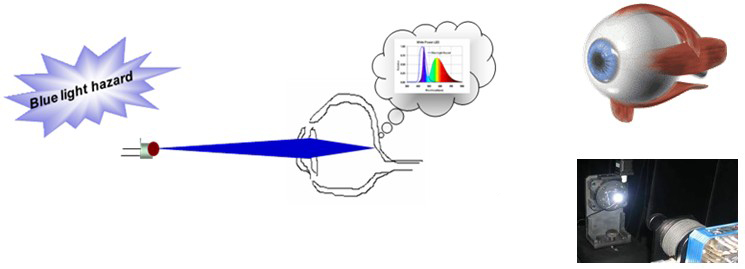Product No: EN62471-C
IEC62471-2006(CIE S009) Photobiological Safety of Lamps and Lamp System and IEC TR62471-2(2009) Guidance on Manufacturing Requirements Relating to Non-laser Optical Radiation Safety have be published addressing hazard to human (mostly eye and skin), and are completely suitable to assess the optical radiation safety of non-laser sources, such as LED products, UV radiation in general lighting products and etc.
The hazard exposure level of optical radiation may be related from 200nm to 3000nm. It is based on the measurement of spectral irradiance and spectral radiance in specified measuring geometry relating with exposure duration.
Standard:
IEC62471-1/EN62471-1 “Photobiological safety of lamps and lamp systems”
CIE S009 / GB/T 20145” Photobiological Safety of Lamps and Lamp Systems”
IEC62471-6:2022 “Photobiological safety of lamps and lamp systems – Part 6: Ultraviolet lamp products”
IEC62471-7:2023 “Photobiological safety of lamps and lamp systems – Light sources and luminaires primarily emitting visible radiation”
IEC/EN 60598/GB 7000.1 “Luminaires-Part1:General requirements and tests”
IEC/EN 60432 “Incandescent lamps – Safety specifications – Part 1: Tungsten filament lamps for domestic and similar general lighting purposes”
IEC60335-2-27 “Household and similar electrical appliances; Safety – Part 2-27: Particular requirements for appliances for skin exposure to ultraviolet and infrared radiation”
IEC60335-2-59 “Household and similar electrical appliances – Safety – Part 2-59: Particular requirements for insect killers”

The IEC 62471 measurement equipment is specialized for the optical radiation hazard exposure level measurement in IEC 62471.
• Actinic UV hazard exposure (weighted irradiance from 200nm to 400nm) for the skin and eye
• Near-UV hazard exposure (irradiance from 315nm to 400nm) for the eye
• Retinal blue light hazard exposure (weighted radiance from 300nm to 700nm)
• Retinal blue light hazard exposure(weighted irradiance, 300-700nm) – small light source
• Retinal thermal hazard exposure (weighted radiance from 380nm to 1400nm)
• Retinal thermal hazard exposure (weighted radiance; 780-1400nm) – weak visual stimulus
• Infrared radiation hazard exposure (irradiance from 780nm to 3000nm) for the eye
• Thermal hazard exposure (irradiance from 380nm to 3000nm) for the skin
Specification:
• Wavelength range: 200nm to 800nm (EN62471-A), 200-1500nm (EN62471-B) and 200-3000nm (EN62471-C)
• Wavelength accuracy: 0.1nm(UV), 0.2nm(VIS), 0.4nm(IR)
• Optical path design: Simulate the imaging optical path of the human eye to accurately evaluate the effective radiation of the human eye’s retina
• Incident aperture: Φ7mm light-receiving aperture, suitable for measurement requirements in all scenarios
• Measuring field of view (fully meeting the standard requirements according to the radiation duration):
1) Effective radiant luminance measurement: 1.5mrad~110mrad (1.7mrad, 11mrad, 100mard)
2)Effective irradiance measurement: 100mrad, 1.4rad and 2πsr
• Testing distance: 200mm~20.0m (optional) with a constant field of view FOVs and input aperture
• 16-bit scientific-grade camera: Resolution 2048*1536, High-precision programmable electric focus
• Calibration traceability: Traceable to the National Institute of Metrology (NIM)
• Maximum exposure scanning range: 2π-space
• Dynamic range: 10^8
• Pulse measurement function (optional): The highest sampling speed is 100kS/s
• High-precision double monochromator spectrometer (optional): PMT/InGaAs/Si/PbS (optional)
